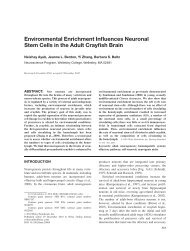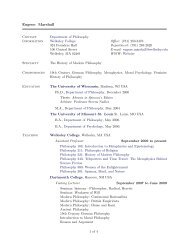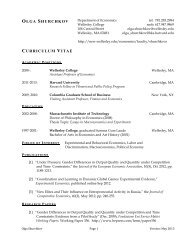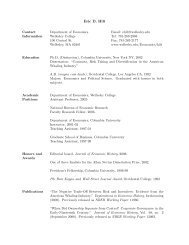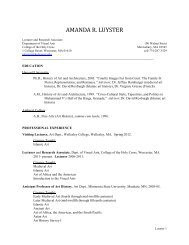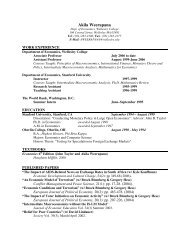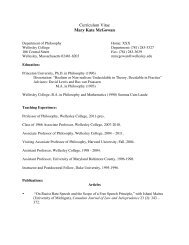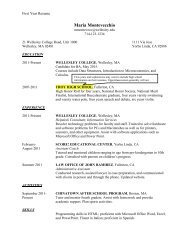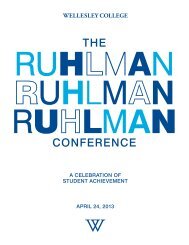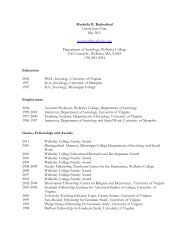Artists' Books in Special Collections - Wellesley College
Artists' Books in Special Collections - Wellesley College
Artists' Books in Special Collections - Wellesley College
You also want an ePaper? Increase the reach of your titles
YUMPU automatically turns print PDFs into web optimized ePapers that Google loves.
fall 2010 | BOOKS UNBOUND | LARGE LESSONS FROM SMALL BEINGS | THE BIG EASY COMEBACK<br />
Our<br />
actions<br />
are<br />
test<strong>in</strong>g<br />
the<br />
resiliency<br />
of the<br />
SeaChanges<br />
ocean
UN<br />
36<br />
wellesley we w ll lles es esle ley | fall fa fall ll 2010 20 2010 10 1<br />
Artists’ books<br />
meld word, image,<br />
color, and texture<br />
<strong>in</strong>to a hybrid form—<br />
books as art. <strong>Wellesley</strong>’s<br />
dynamic collection, housed<br />
at the Clapp Library, addresses<br />
issues of gender, race, politics,<br />
science, and religion, challeng<strong>in</strong>g<br />
our sense of what books can do and be.<br />
BOOKS<br />
BOUND<br />
By Francie Latour<br />
Photographs by Just<strong>in</strong> Knight<br />
Th e Way to Be Empty I<br />
Sun Young Kang<br />
University of the Arts, Philadelphia<br />
26 cm.<br />
Number 7 of 10 copies
WE KNOW some th<strong>in</strong>gs<br />
about books and art: for example, that<br />
works of art generally hang on walls, and literary works generally sit<br />
on shelves. We know the feel<strong>in</strong>g of be<strong>in</strong>g stirred by a Van Gogh or immersed<br />
<strong>in</strong> Toni Morrison. And we know how diff erent those two experiences can be.<br />
What, then, to make of artists’ books?<br />
Not art books, which sit on coff ee tables. Or books about art, which students<br />
carry <strong>in</strong> backpacks. Artists’ books are someth<strong>in</strong>g else entirely, and many<br />
th<strong>in</strong>gs at once. Th ey are books as art, whose hybrid form and emotional power<br />
have made them a force <strong>in</strong> contemporary art. And among the colleges and<br />
universities collect<strong>in</strong>g these art objects, <strong>Wellesley</strong> is at the cutt<strong>in</strong>g edge: Under<br />
<strong>Special</strong> <strong>Collections</strong> Librarian Ruth Rogers and her predecessors, the <strong>College</strong><br />
has built an absorb<strong>in</strong>g, dynamic collection of artists’ books that speak to the<br />
liberal-arts curriculum. With about 1,500 works, and particularly strong<br />
selections that address race, gender, politics, literature, and the Holocaust, it’s<br />
a collection of wide-rang<strong>in</strong>g aesthetics and serious <strong>in</strong>tellectual punch.<br />
Born <strong>in</strong> the artistic experimentation of the 1960s, contemporary<br />
artists’ books have come <strong>in</strong>to their own as a dist<strong>in</strong>ct art genre. Th ese works<br />
deliver far more than the sum of their many <strong>in</strong>tegrated parts: Artists’ books<br />
are meant to be viewed and read, opened and touched. Th ey reawaken<br />
us to all that makes books sacred—their <strong>in</strong>timacy, their universality, their<br />
transport<strong>in</strong>g power. But they also puncture, and sometimes even explode,<br />
our sense of what books can do and be.<br />
“Artists’ books force us to see and comprehend their mean<strong>in</strong>g not<br />
through one dimension, such as text, but through the sum of all their<br />
elements: form, materials, color, texture, and words,” says Rogers. To fully<br />
appreciate them, she says, there is only<br />
one requirement: “You must suspend your<br />
expectation that a book is a narrative text with a beg<strong>in</strong>n<strong>in</strong>g and<br />
end, bound securely between two covers.”<br />
Th e value of contemporary artists’ books across the curriculum has<br />
only begun to be tapped, Rogers says. Currently, about a<br />
half-dozen courses draw on the collection, from religion to<br />
comparative literature to art history, as well as <strong>Wellesley</strong>’s<br />
writ<strong>in</strong>g program and the book-arts program. Rogers hopes<br />
to expand the collection’s reach to Africana studies, women’s<br />
and gender studies, and political science, among others.<br />
Liv<strong>in</strong>g With Others<br />
Carl T. Heyward<br />
1987<br />
Carl T. Heyward, publisher,<br />
San Francisco<br />
21 cm.<br />
Unique altered book<br />
Religion Professor Barbara Geller, who teaches a course on the<br />
Holocaust, has seen dozens of her students silenced and chilled by these new<br />
avenues of expression. “It’s a transformative educational moment for them,”<br />
she says, “and I th<strong>in</strong>k it’s both about the degree to which they’re respond<strong>in</strong>g<br />
to the subject matter as well as the forms of the books themselves. Each time<br />
you return to them, you uncover another layer of complexity.”<br />
Few college or university collections can match the richness or depth of<br />
<strong>Wellesley</strong>’s, says Betty Bright, an <strong>in</strong>dependent curator and lead<strong>in</strong>g voice on<br />
artists’ books who founded the M<strong>in</strong>nesota Center for Book Arts. “<strong>Wellesley</strong> is<br />
one of a handful of <strong>in</strong>stitutions that have built a stellar reputation <strong>in</strong> the fi eld<br />
of the book arts,” says Bright. “A number of the books are just stunn<strong>in</strong>g <strong>in</strong><br />
the quality of their execution and <strong>in</strong> the <strong>in</strong>ventiveness of their construction.”<br />
As the follow<strong>in</strong>g books suggest, the potential of artists’s books for<br />
<strong>in</strong>terdiscipl<strong>in</strong>ary learn<strong>in</strong>g is rich and deep. “Th ese are liv<strong>in</strong>g, tactile, usable<br />
treasures by liv<strong>in</strong>g artists and writers,” says Rogers. “Th ey communicate.”<br />
fall 2010 | wellesley<br />
37
38<br />
wellesley | fall 2010<br />
Ghost Poems for the Liv<strong>in</strong>g<br />
Paulette Myers-Rich/William Shakespeare<br />
2005<br />
Traffi c Street Press, St. Paul, M<strong>in</strong>n.<br />
28 cm.<br />
26 copies<br />
HOW DO YOU ALTER the poetry of a man<br />
regarded as the greatest writer <strong>in</strong> the English<br />
language? How to reorder words considered<br />
to be immortal, and br<strong>in</strong>g new art <strong>in</strong>to be<strong>in</strong>g?<br />
Tomes upon tomes have been devoted<br />
to William Shakespeare, his pentameter<br />
<strong>in</strong>terpreted and re<strong>in</strong>terpreted by scholars<br />
through the ages. Paulette Myers-Rich enters<br />
this terra<strong>in</strong> armed with noth<strong>in</strong>g more than<br />
a medium-format camera, handmade fl ax<br />
paper, and 13 Shakespeare sonnets on<br />
mortality and middle age. Th e result is a<br />
stirr<strong>in</strong>g meditation on loss and renewal:<br />
With quatra<strong>in</strong>s vanish<strong>in</strong>g <strong>in</strong>to free verse<br />
and images of fl owers that seem to curl<br />
<strong>in</strong>to vapor, Ghost Poems for the Liv<strong>in</strong>g is a<br />
haunt<strong>in</strong>g whisper to the Bard across the ages.<br />
In 13 pair<strong>in</strong>gs, Myers-Rich presents<br />
the orig<strong>in</strong>al sonnet and an image of nature<br />
<strong>in</strong> decay. Th ese photographs are image<br />
poems—seed pods and blades, leaves and<br />
sheaths twist<strong>in</strong>g <strong>in</strong> pure shadow and light.<br />
Turn the page, and two ghostly images<br />
appear: the photograph aga<strong>in</strong>, now with<br />
positive reversed to negative, and fragments<br />
of free verse excavated from the previous<br />
page. In Sonnet 73—one of Shakespeare’s<br />
most famous, where metaphors of autumn<br />
and dy<strong>in</strong>g fi res abound—Myers-Rich fi nds<br />
a poem <strong>in</strong>side the poem: “behold/yellow<br />
leaves/shake aga<strong>in</strong>st the cold,/twilight/fadeth/<br />
black night/seals/such fi re/on the ashes.”<br />
To read Shakespeare’s Sonnet 73<br />
<strong>in</strong> its entirety, visit http://www.poets.org/<br />
viewmedia.php/prmMID/15844.
Sanctus Sonorensis<br />
Philip Zimmermann<br />
2009<br />
Spaceheater Editions, Tucson, Ariz.<br />
21 cm.<br />
Edition of 1,000 copies<br />
SANCTUS SONORENSIS is a book of prayer. Like ancient religious texts,<br />
its power lies <strong>in</strong> the way it quiets and centers us: through illum<strong>in</strong>ated<br />
text, through its weight and gilded edges, through chanted repetition.<br />
But this missal speaks to a modern-day American fl ock—a country<br />
divided over the immigrants cross<strong>in</strong>g our borders, and exhausted by<br />
the scream<strong>in</strong>g debate that defi nes immigration politics.<br />
In the Catholic mass, the Sanctus is a hymn sung with solemn<br />
voices. Sanctus carries that hymn <strong>in</strong>to Arizona’s Sonora<br />
The desert sky:<br />
Desert, a place where thousands slip through search<strong>in</strong>g for<br />
(above) ‘blessed are<br />
the day laborers.’ opportunity, and thousands die search<strong>in</strong>g. Zimmermann’s<br />
work shows us noth<strong>in</strong>g of what happens on that treacherous<br />
ground. Instead, it opens to hypnotic images of desert sky that<br />
progress from dawn to dusk. Each pass<strong>in</strong>g hour fi lls the page with<br />
limitless blue expanse, with clouds stretched over sun, with stray<br />
lightn<strong>in</strong>g or scatter<strong>in</strong>g birds—then, with sheets of mournful,<br />
gather<strong>in</strong>g darkness. Each sky carries its own beatitude:<br />
blessed are the pool boys.<br />
blessed are the pecan gatherers.<br />
blessed are the offi ce-cleaners,<br />
blessed are the shepherds.<br />
blessed are the garbage men.<br />
blessed are the domestic workers.<br />
“I have always liked repeated, or almost chanted, texts,”<br />
Zimmermann says. Quot<strong>in</strong>g a fellow book artist, he says, “Ritualized<br />
language can be an eff ort to make slow change through repetition. It<br />
can be both an eff ort to change, and a way to deal with the fact that<br />
change may not come.”<br />
To read more about Philip Zimmermann,<br />
go to http://philipzimmermann.blogspot.com/.<br />
fall 2010 | wellesley<br />
39
40<br />
Out of the Sky<br />
Werner Pfeiff er<br />
2006<br />
Pear Whistle Press, Red Hook, N.Y.<br />
34 cm. closed; 161 cm. assembled<br />
Number 12 of 52 copies<br />
THE POWER OF THE ARTIST’S BOOK lies <strong>in</strong> the<br />
way it jo<strong>in</strong>s content with form; the experience<br />
of the object not only echoes the text’s<br />
mean<strong>in</strong>g, but deepens it. In imag<strong>in</strong><strong>in</strong>g a book<br />
about Sept. 11, New York artist Werner<br />
Pfeiff er realized he could only build it <strong>in</strong> one<br />
way: up. Out of the Sky is that rare object<br />
that fuses pr<strong>in</strong>tmak<strong>in</strong>g, sculpture, poetry,<br />
and history. A monument and a vessel, it<br />
requires us to physically construct and<br />
collapse two towers <strong>in</strong> order to read it.<br />
Pfeiff er watched the actual towers burn<br />
from a Brooklyn rooftop. His piece began<br />
with sketches of what he witnessed—bodies<br />
<strong>in</strong> free fall as victims leaped to their deaths.<br />
A chaos of limbs evok<strong>in</strong>g Picasso’s Guernica,<br />
the woodcuts open <strong>in</strong>to cubes that stack over<br />
<strong>in</strong>ner support structures. As the towers rise,<br />
so do the victims’ names, <strong>in</strong> letterpress type<br />
alternately bolded and unbolded to echo the<br />
corrugated steel of the World Trade Center.<br />
Once built, the tw<strong>in</strong> towers can be deconstructed<br />
and folded back <strong>in</strong>to the recessed<br />
metal cavities of the accompany<strong>in</strong>g handmade<br />
box.<br />
As a child <strong>in</strong> World War II Germany,<br />
Pfeiff er’s house was bombed, forc<strong>in</strong>g his<br />
family <strong>in</strong>to the basement as the upper stories<br />
caved <strong>in</strong>. Pfeiff er’s accompany<strong>in</strong>g booklet<br />
speaks to those triggered memories and our<br />
collective need to heal, “to probe for guid<strong>in</strong>g<br />
spiritual markers with<strong>in</strong> ourselves.”<br />
To view a video of Pfeiffer discuss<strong>in</strong>g<br />
Out of the Sky, visit http://www.youtube.com/<br />
watch?v=bh9ovBzCYYw.<br />
wellesley | fall 2010
Billy Rabbit: An American Adaptation<br />
Ann Tyler<br />
2007<br />
Ann Tyler, publisher, Chicago<br />
39 cm.<br />
Number 3 of 50 copies<br />
THERE’S A REASON little kids fi nd lift-the-fl ap books so captivat<strong>in</strong>g. Th e play between<br />
words, pictures, and peek-a-boo makes children active participants <strong>in</strong> a fairy-tale<br />
world—not just watch<strong>in</strong>g and listen<strong>in</strong>g, but mov<strong>in</strong>g the story along.<br />
In Billy Rabbit: An American Adaptation, Ann Tyler pulls us <strong>in</strong>to a dist<strong>in</strong>ctly American<br />
once-upon-a-time, a tale of hide and seek marked by mob ritual and harrow<strong>in</strong>g violence: the<br />
lynch<strong>in</strong>g. Weav<strong>in</strong>g together an English children’s story about a rabbit steal<strong>in</strong>g a turnip with<br />
accounts of lynch<strong>in</strong>gs from US newspapers, Tyler <strong>in</strong>jects ferocious cruelty and suff ocat<strong>in</strong>g<br />
doom <strong>in</strong>to a genre normally reserved for s<strong>in</strong>gsong <strong>in</strong>nocence. Th e device for her cautionary<br />
tale couldn’t be more apt: In Billy Rabbit, we not only turn the pages, we hold and lift the<br />
well-used <strong>in</strong>struments. Th e hammer, the saws, the butcher’s knife, the pitchfork.<br />
In the orig<strong>in</strong>al 1912 story (also <strong>in</strong> <strong>Wellesley</strong>’s collection), the rabbit is rescued by his mother. But<br />
lynch<strong>in</strong>gs don’t make for happy end<strong>in</strong>gs, a fact that makes Tyler’s decision to end her book with<br />
l<strong>in</strong>es excerpted from the orig<strong>in</strong>al version all the more chill<strong>in</strong>g. “When Billy didn’t come home by<br />
dusk, Mrs. Bunny began to get anxious, so she took down a lantern and walk<strong>in</strong>g-stick and set out to<br />
fi nd him. ‘And I heard somebody say that rabbits were <strong>in</strong> season, too,’ she thought with a sigh.”<br />
fall 2010 | wellesley<br />
41
42<br />
wellesley | fall 2010
Le 6 Avril, 1944<br />
Jacques Fournier/Edward Hillel<br />
1999<br />
Éditions Rosel<strong>in</strong>, Montréal<br />
17 by 25 by 10 cm. (box)<br />
Number 41 of 44 copies<br />
BOOK ARTISTS CONSCIOUSLY SEEK to push<br />
the boundaries of the book form. At the<br />
same time, their craft rem<strong>in</strong>ds us of the<br />
book’s essential place and symbolic power<br />
<strong>in</strong> human civilization. In consider<strong>in</strong>g the<br />
Holocaust, a collaborative work by Jacques<br />
Fournier and Edward Hillel takes our<br />
understand<strong>in</strong>g of what a book should be<br />
to its outer limits. One of the most viewed<br />
books <strong>in</strong> the collection, it has the eff ect<br />
of stopp<strong>in</strong>g students <strong>in</strong> their tracks when<br />
they encounter it.<br />
Th e subject of Le 6 Avril, 1944 is the<br />
deportation and gass<strong>in</strong>g of 44 children<br />
from the village of Izieu, France. We lift<br />
a box lid <strong>in</strong> the unmistakable, Nazi-era<br />
yellow of the cloth patch Jews were<br />
ordered to wear to mark them <strong>in</strong> public.<br />
What we fi nd <strong>in</strong>side suggests a haunt<strong>in</strong>g,<br />
electric presence fl oat<strong>in</strong>g <strong>in</strong> empty<br />
space: the stamped names and ages of the<br />
victims, entombed but also ris<strong>in</strong>g from a<br />
village hillside depicted along the box’s<br />
refl ective <strong>in</strong>ner walls.<br />
But is it a book? Fournier, a bookb<strong>in</strong>der<br />
by trade, chose to l<strong>in</strong>e his work<br />
with a heavy, lead bottom, <strong>in</strong>tensify<strong>in</strong>g<br />
its coffi nlike feel. Ruth Rogers, head of<br />
<strong>Special</strong> <strong>Collections</strong>, says Le 6 Avril meets<br />
one of her essential criteria for artists’<br />
books, works that “re<strong>in</strong>force the liberalarts<br />
curriculum by say<strong>in</strong>g someth<strong>in</strong>g that<br />
can’t be said <strong>in</strong> any other medium.”<br />
fall 2010 | wellesley<br />
43
44<br />
wellesley | fall 2010<br />
Femmes Fatales<br />
Maureen Cumm<strong>in</strong>s<br />
2001<br />
Maureen Cumm<strong>in</strong>s, publisher, High Falls, N.Y.<br />
29 cm.<br />
Number 24 of 50 copies<br />
IT’S THE KIND OF TREASURE you’d fi nd <strong>in</strong> your<br />
grandmother’s attic: v<strong>in</strong>tage photographs<br />
of women from another time, bound <strong>in</strong> a<br />
Victorian-era album with a brass clasp and<br />
gilded pages. But the allur<strong>in</strong>g women of<br />
Femmes Fatales signify someth<strong>in</strong>g much<br />
darker than their sepia tones suggest: Th eir<br />
titles, spelled out <strong>in</strong> gold letter<strong>in</strong>g, all refer<br />
to torture and execution devices through the<br />
ages. Th e Ropemaker’s Daughter, a nickname<br />
for a noose. Th e Lady of the Carousel,<br />
moniker for the guillot<strong>in</strong>e. Yellow Mama,<br />
otherwise known as the electric chair.<br />
Maureen Cumm<strong>in</strong>s is as much an<br />
archival historian as she is a book artist. Her<br />
award-w<strong>in</strong>n<strong>in</strong>g works, many of which are<br />
<strong>in</strong> <strong>Wellesley</strong>’s collection, illum<strong>in</strong>ate matters<br />
of gender, race, and power by go<strong>in</strong>g to the<br />
source. Cumm<strong>in</strong>s’ Th e Bus<strong>in</strong>ess Is Suff er<strong>in</strong>g<br />
quietly chronicles the woes of a Virg<strong>in</strong>ia<br />
slave-trad<strong>in</strong>g fi rm <strong>in</strong> decl<strong>in</strong>e, as revealed <strong>in</strong><br />
a collection of bus<strong>in</strong>ess correspondence. Th e<br />
playful Anatomy of Insanity uses century-old<br />
psychiatric records from McLean Hospital to<br />
disturb<strong>in</strong>g eff ect: While men at the legendary<br />
Boston-area psychiatric hospital were<br />
found <strong>in</strong>sane for a wide variety of reasons,<br />
women were found <strong>in</strong>sane mostly due to<br />
their own biology—menstruation, lactation,<br />
menopause, desire. Cumm<strong>in</strong>s off ers up these<br />
histories with a gorgeous sense of aesthetics,<br />
<strong>in</strong>vit<strong>in</strong>g us to make connections while carefully<br />
avoid<strong>in</strong>g tell<strong>in</strong>g us what to th<strong>in</strong>k.<br />
To view more of Cumm<strong>in</strong>s’ work, go to<br />
http://www.maureencumm<strong>in</strong>s.com/.
26° 57.3´ N, 142° 16.8´ E<br />
Veronika Schäpers<br />
2007<br />
Schäpers, Tokyo<br />
46 cm.<br />
Number 3 of 44 copies<br />
CAN A BOOK RECREATE THE EXPERIENCE of be<strong>in</strong>g at sea, <strong>in</strong> search of an underwater creature? Herman Melville<br />
used every literary device <strong>in</strong> his arsenal to put us on a ship deck with a wander<strong>in</strong>g sailor, voyag<strong>in</strong>g to capture a<br />
whale. In Veronika Schäpers’ diaphanous book, the artist uses her own tools—color, texture, and even sound—<br />
to <strong>in</strong>terpret the ocean’s mysteries and the discovery of another mythic monster: the giant squid, captured on<br />
fi lm <strong>in</strong> its natural habitat for the fi rst time <strong>in</strong> 2004 near Japan.<br />
Th e book’s elongated form evokes the traditional nautical log; its title represents the coord<strong>in</strong>ates where the<br />
giant squid was found. But it’s Schäpers’ stunn<strong>in</strong>gly delicate pr<strong>in</strong>t<strong>in</strong>g and <strong>in</strong>k<strong>in</strong>g techniques that submerge us.<br />
Th e v<strong>in</strong>tage, translucent paper on which she sets her text—poetry, l<strong>in</strong>e-drawn maps, and nautical data from the<br />
2004 voyage—recreates the rush of ocean waves as we turn the pages. Carefully folded to leave narrow open<strong>in</strong>gs<br />
that evoke both the horizon and the lens of an underwater camera, the pages reveal <strong>in</strong>ner layers of partially<br />
visible text and shifts of lum<strong>in</strong>ous color, from blurred blues and grays to the black of the ocean fl oor.<br />
Schäpers, a German native who lives <strong>in</strong> Japan, has seen her work enter collections such as New York’s<br />
Museum of Modern Art. With<strong>in</strong> <strong>Wellesley</strong>’s collection, 26° 57.3´ N, 142° 16.8´ E off ers a meditation uniquely<br />
suited for the liberal arts—an exploration of myth and mar<strong>in</strong>e biology, of high art and rigorous science.<br />
Francie Latour is an associate editor of <strong>Wellesley</strong> magaz<strong>in</strong>e.<br />
To see more artists’ books<br />
<strong>in</strong> the collection, go to http://www.<br />
wellesley.edu/Library/SpecColl/<br />
rrbooklet/<strong>in</strong>tro.html or http://<br />
web.wellesley.edu/web/Dept/LT/<br />
<strong>Collections</strong>/SpecColl/bkarts.psml.<br />
fall 2010 | wellesley<br />
45



